Test dei Cristalli
PILOT STUDY: can droplet evaporation method revel differences between prano-therapy treated and non-treated water samples?
Dr. Maria Olga Kokornaczyk
Abstract
Water samples (with and without the addition of physiological salts) were submitted to prano-therapy and analyzed for their crystallographic properties in confront to the untreated controls. The analysis was performed by means of the droplet evaporation method (DEM). Two different experimental protocols were applied to the water samples: (i) an inorganic protocol consisting in the evaporation of droplets of the water samples, and (ii) an organic protocol consisting in the evaporation of wheat seed leakage droplets prepared with the water samples without the salt content, aiming the analysis of the impact of the water sample upon a living organism. Patterns received from both experimental protocols were evaluated by means of the computer software ImageJ. Several differences between the patterns obtained from treated vs. non-treated water samples were found regarding above all the sizes of the structures. Threated water raised also the regularity of the wheat seed leakage patterns.
Introduction
DEM is a method based on pattern formation in evaporating droplets and a subsequent evaluation of the obtained structures. The patterns created during the evaporation of solution droplets can by the result of different pattern-forming processes, like: crystallization, aggregation or coagulation. Many studies have demonstrated that the shapes and sizes of the different structures formed in the desiccated droplets depend on both, the composition of the evaporation solution and sample quality/health, and thus may serve for analytical purposes [1-5].
The aim of the here described pilot-study was to see whether prano-therapy applied to water samples induces changes detectable via DEM. For the analysis two kinds of protocols were applied (i) an inorganic protocol, consisting in the evaporation of water droplets, aiming the analysis of the pattern formatting properties of the samples and (ii) the organic protocol, consisting in the evaporation of leakage droplets obtained through placing wheat seeds into the water samples, aiming the analysis of possible influence of the samples on a living organism. Patterns received from evaporated droplets were evaluated visually and by means of the computer software ImageJ for chosen size- and shape-describing paramters.
Materials and methods
Water samples: 12 water samples were supplied by SAMIARC: 6 samples contained physiological salts and 6 were ultra-pure water samples. 3 samples of each sample kind contained ca. 10% of a ‘mother tincture’ e.s. water subjected to a prano-therapy treatment and 3 were the corresponding controls. In case of the water samples with salt addition the mother tincture was DUM AUGMENTIN and in case of the ultra-pure water samples it was TALITA KUM. The samples were blinded and coded by a person not involved in the experimentation; samples decoding was done after the pattern evaluation.
DEM: DEM was performed applying two different experimental protocols, described in detail in [3,5], (i) the inorganic protocol consisting in the evaporation of water droplets [3] and (ii) the organic protocol consisting in evaporation of leakages obtained by placing wheat seeds into the analyzed water sample [5].
– Inorganic protocol (applied to all samples): Out of each water sample 3µl droplets were placed on microscope slides in 3 replicates (3 randomly placed rows, each containing 5 drops). The evaporation was performed in a thermostat at 25°C.
– Organic protocol (applied only to ultrapure water samples e.s. without the salt addition): 5 clean and undamaged winter wheat seeds (cv. Inallettabile coming from a biodynamic farm, harvesting year 2010) were placed in 5 ml of each water sample and left at room temperature for 1h. After this time 3µl droplets were placed on microscope slides in 3 replicates (3 randomly placed rows, each containing 5 drops). The evaporation was performed in a thermostat at 25°C.
After the evaporation the droplet residues were analyzed visually and photographed under a dark field microscope in magnifications 25x and 100x.
Pattern evaluation: The pattern evaluation was performed by means of the ImageJ software [6]. Water images (inorganic protocol) in magnification 25x and wheat seed leakage images (organic protocol) in magnification 100x were used for the evaluation. The images were converted to binary option (black background and white structures) and analyzed by means of the particle analyze tool for several size- and shape-describing parameters. Wheat seed leakage images were additionally analyzed by means of the plug-in FRAC-LAC [7] for the fractal dimension of the polycrystalline structures.
Statistics: All data were processed by two-way analysis of variance; the separation of means was performed using Fisher’s least significant difference test at a significance level of p ≤ 0.05. To the staistical analysis the CoStat software (version 6.002, Cohort Software, Montery, CA, USA) was used.
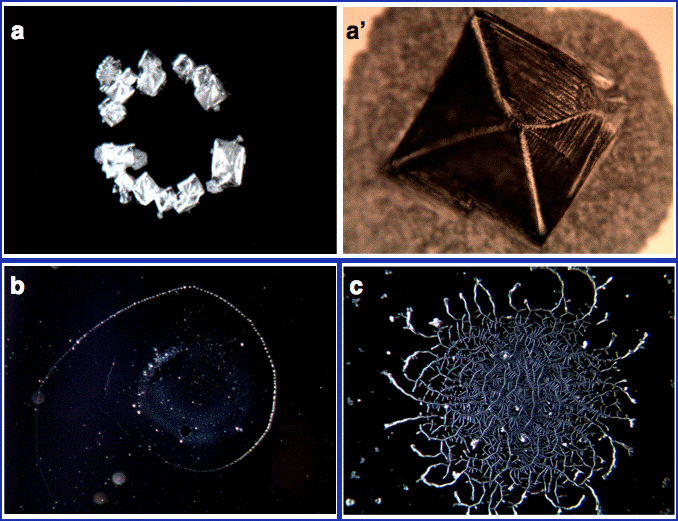
FIGURE 1: Examples of patterns obtained throu the evaporation of water droplets containing physiological salts (a, a’), pure water droplets (b) and droplets of wheat seed leakages (c).
Results
General description
The patterns obtained in the present experiment were of three kinds: (i) patterns containing crystals typical for evaporated NaCl solutions (inorganic protocol applied to the water samples with salt content; Figure 1a,a’); (ii) patterns typical for evaporated water/spring water samples (inorganic protocol applied to water samples without the salt addition; Figure 1b); and (iii) patterns typical for evaporated wheat seed leakage droplets (organic protocol applied to water samples without the salt content; Figure 1c).
Pattern evaluation
Patterns obtained form water samples with salt content (inorganic protocol)
The patterns contained NaCl typical crystals e.s. three-dimensional, pyramid-shaped structures with visible lines forming a ‘x’ sign. Besides these pyramid-like structures there were also areas covered with small and uniform crystal structures usually connected or circulating the NaCl crystals. The pattern evaluation showed that patterns deriving from treated and untreated water samples differed significantly for what concerns several size and shape describing parameters of the formed structures. The total area and perimeter of the structures formed from the treated samples were significantly lower and their circularity was higher, indicating a more compact structure formation in treated vs. non-treated samples (Figure 2).
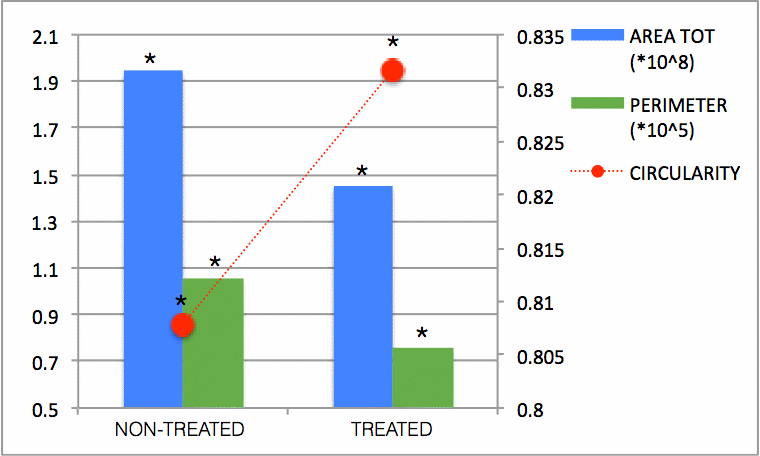
FIGURE 2: Graphical representation of the values of size- (area, perimeter) and shape-describing parameters (circularity) of structures formed from treated vs. non-treated water samples containing physiological salts.
Patterns obtained from water samples without salt content (inorganic protocol)
The patterns were typical for spring water, e.s. consisted out of inner-structures of great variety of shapes (deposits without dendrite-formation) and a borderline, or some circles of lines indicating the changing position of the droplet-border during phase transition. The pattern evaluation showed that patterns deriving from treated and untreated water samples differed significantly for what concerns several sizing parameters of the formed structures (Figure 3). Patterns from treated water samples contained significantly less structures; the structures were smaller (they covered a smaller area); however the mean perimeter of all structures within one droplet was significantly higher for the treated samples indicating more elongated structures, like for instance the line-circles due to the changing position of the droplet border.
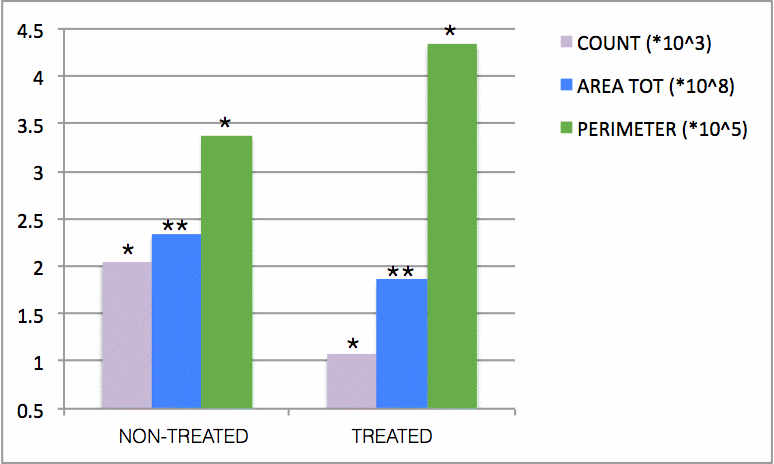
FIGURE 3: Graphical representation of the values of sizing parameters (count, area, and perimeter) of structures formed from treated vs. non-treated water samples without salt content.
Patterns obtained from wheat seed leakages prepared with water samples without the salt content (organic protocol).
The patterns were typical for wheat seed leakages e.s. consisted out of dendritic polycrystalline structures placed in the droplets center and a borderline; there were no structures (or only few dot-like deposits) in-between the borderline and the centrally placed polycrystalline structures. The pattern evaluation showed that patterns deriving from wheat seed leakages prepared with treated and untreated water samples differed significantly for what concerns several sizing parameters of the formed structures (Figure 4).
The treated samples created structures with significantly longer perimeter and, in opposite to patterns deriving from the inorganic protocol, here the mean area of the structures was higher then in those from non-treated water samples (difference insignificant; however, the result is different then in the two inorganic protocols where the area was significantly lower in the treated samples).
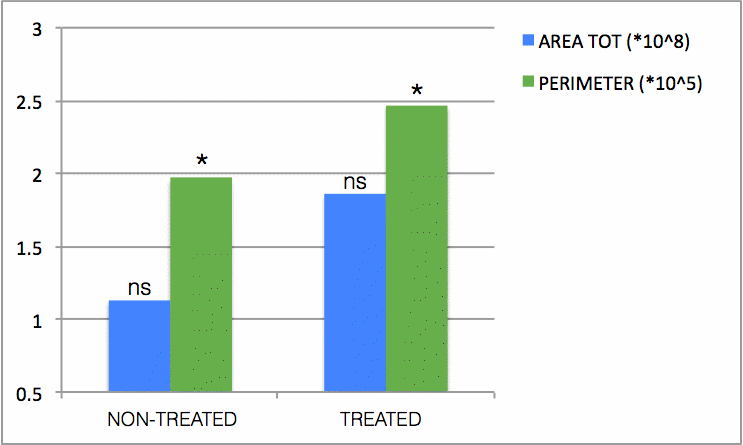
FIGURE 4: Graphical representation of the values of sizing parameters (area and perimeter) of structures formed from wheat seed leakages prepared with treated vs. non-treated water samples without salt content.
The results from all three applied experimental protocols were significant at p<0.05; the two way ANOVA showed no significant differences between the sample replicates for the results of the inorganic protocol applied on water samples containing physiological salts; in the pure water samples (without salt content) one replicate of the treated samples differed significant from the other two in both experiments (ii and iii).
Visual pattern evaluation
Patterns obtained form water samples with salt content (inorganic protocol)
The results obtained through the computerized pattern evaluation can be noted also in the visual approach: patterns form treated water samples with salt content created more compact and ‘exact’ structures, whereas the structures in control patterns occupied a larger area and seemed more irregular (Figure 5).
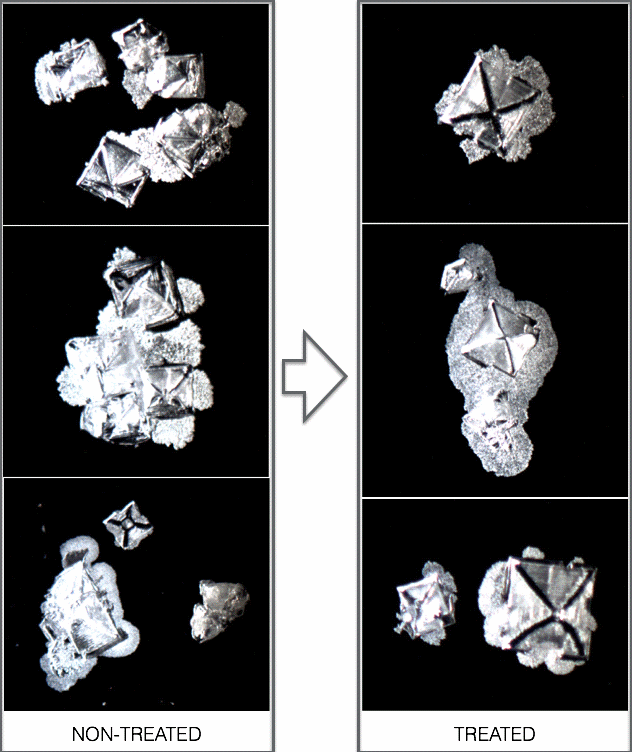
FIGURE 5: Examples of patterns obtained from evaporating droplets of non-treated vs. treated water samples with salt content (inorganic protocol).
Patterns obtained from water samples without salt content (inorganic protocol)
In case of patterns obtained from the water samples without salt content the visual assessment is rather difficult because of the large variety of structure shapes, which can observed in droplet deposits. However also here, it could be observed that patterns from treated samples created often regular and more complex structures in confront to control (Figure 6).
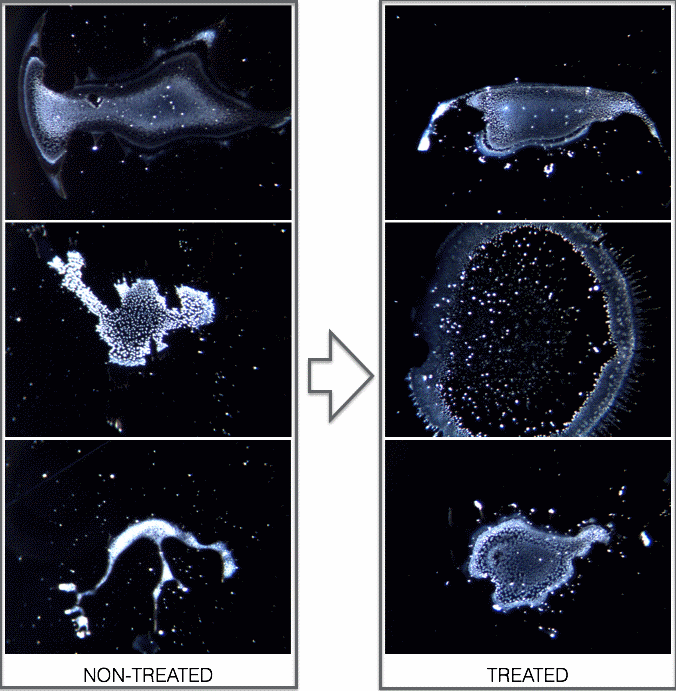
FIGURE 6: Examples of patterns obtained from evaporating droplets of non-treated vs. treated water samples without salt content (inorganic protocol).
Patterns obtained from wheat seed leakages prepared with water samples without the salt content (organic protocol).
Through the visual assessment of patterns obtained in the organic protocol clear and easily notable differences could be found between the two samples regarding above all the regularity of structures, which was higher in the treated water samples in confront to the control (Figure 7).
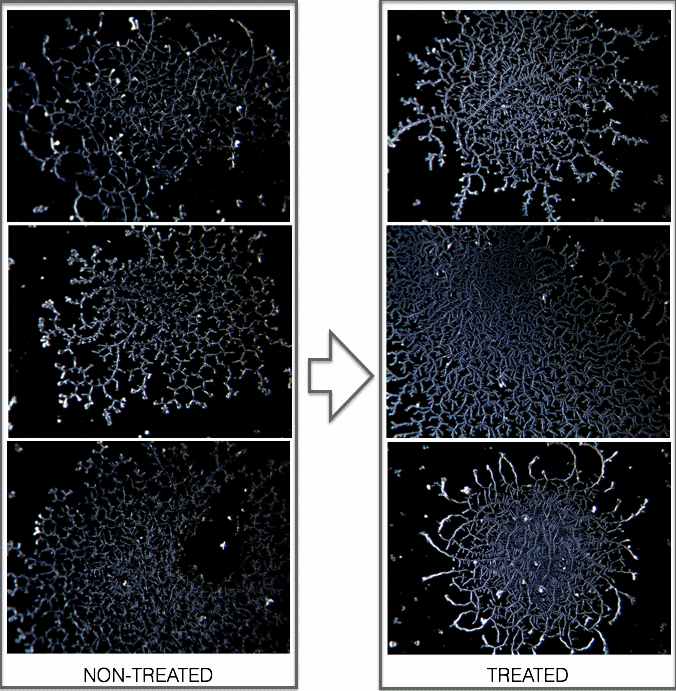
FIGURE 7: Examples of patterns obtained from evaporating droplets of wheat seed leakages prepared with non-treated vs. treated water samples (organic protocol).
Discussion
The results deriving from all the three applied experimental protocols have shown some significant differences between the treated vs. non-treated water samples indicating that DEM might be considered a suitable tool for analyzing differences in water samples due to prano-therapy.
In both experimental protocols applied on the water samples without salt content one sample replicate of the treated samples (sample with code 9) differed greatly from the other two, which might indicate some other kind of error during the sample preparation. The results of the organic protocol deriving from both the computerized and visual pattern evaluation (higher structure perimeter and higher structure regularity in patterns from the treated water samples) indicate a positive impact of the treated water samples on wheat seeds, however more treatment replicates should be analyzed.
Conclusions
DEM might be considered an appropriate tool for analyzing water samples subjected to prano-therapy treatments. The possibility to analyze both, the sample by itself through the application of the inorganic protocol and the impact of the treated water sample on wheat seeds through the application of the organic protocol, seems to be very promising for further experimentations.
The experimentations should be repeated with more replicated per treatment.
References
T. Yakhno, V. Yakhno, A. Sanin, O. Sanina, and A. Pelyushenko, “Dynamics of phase transitions in drying drops
as an information parameter of liquid structure,” Nonlinear Dynamics, vol. 39, no. 4, pp. 369–374, 2005.
K. Sefiane, “On the formation of regular patterns from drying droplets and their potential use for bio-medical applications,” Journal of Bionic Engineering, vol. 7, supplement, pp. S82–S93, 2010.
Kokornaczyk MO, Parpinello GP, Versari A, Rombolà AD, Betti L (2014) Qualitative discrimination between organic and biodynamic Sangiovese red wines for authenticity. Analytical Methods. DOI: 10.1039/C4AY00971A.
Kokornaczyk MO, Trebbi G, Dinelli G, Marotti I, Bregola V, Nanni D, Borghini F, Betti L (2014) Droplet evaporation method as a new potential approach for highlighting the effectiveness of ultra high dilutions. Complementary Therapies in Medicine 22, 333-340.
Kokornaczyk MO, Dinelli G, Marotti I, Nanni D, Benedettelli S, Betti L (2011) Self-assembled crystallization patterns from evaporating droplets of common wheat grain leakages. TheScientificWorldJOURNAL 11, 1712-1725.
T. J. Collins, “ImageJ for microscopy,” BioTechniques, vol. 43, no. 1, pp. 25–30, 2007.
A. Karperien, (1999–2007) FracLac for ImageJ, version 2.5. http://rsb.info.nih.gov/ij/plugins/fraclac/FLHelp/Introduction.htm